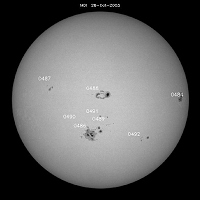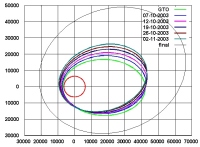No. 5 - SMART-1 is finding her way through the radiation storms!!
SMART-1, like many other spacecraft, has suffered in this harsh environment. The star tracker, the onboard computer and the electric propulsion system experienced major disturbances compared to normal operations. Despite this, we operated the spacecraft in electric propulsion mode and have now generated thrust for a total cumulated time of more than 380 hours and have consumed about 6 kg of Xenon fuel in the process.
 |
|
Figure 1: Distribution of the very active regions on the solar disc at the end of October |
The electric power degradation, due to the radiation environment, is about as expected. There was a sharp degradation at the beginning of the solar storms around 20 October, but more recently the degradation has softened up and we have now an average loss of less than 2 Watts per day. At this rate we still have good margin with respect to the end of life power predictions.
The communication, data handling and on-board software subsystems have been performing generally well. The increased radiation level, however, has caused, quite as expected, a few warm resets of the main computer and one switchover to the redundant computer. The spacecraft has reacted correctly to the events and nominal operations were recovered at the following ground contacts. The drawback, however, is that the planned operations are often disrupted.
The thermal subsystem continues to perform well and all the temperatures are as expected. The only item of concern is the slight increase of the star tracker optical head temperature during part of the orbit. This is a problem if it coincides with the use of the camera during periods of high radiation. The thermal engineers are looking into the possibilities to reduce the temperature of the star tracker optical heads.
The attitude control subsystem continues to work well in general. The star trackers have been working rather well, after the software modifications described in the last report. In the last period we only had two attitude drop-outs: one when one of the two star trackers was blinded by the Earth and the other when one star tracker had a relatively high temperature and was under heavy proton bombardment. There were no consequences, though, as the attitude control system is designed to cope with such situations. The main problem now is that the radiation dose received by the CCD of the camera heads is approaching what we were expecting by the end of the mission. In such a condition the star trackers can still provide good attitude data only if the temperature is relatively low (< 10 °C). It is desirable, therefore, to reduce the temperature of the star trackers as much as possible.
In the next few days we are planning to make some test observations with the AMIE camera. Possible targets are being presently analysed. More on the subject in the next report.
Orbital/Trajectory information
The effects of the electric propulsion low thrust continuously modify the SMART-1 orbit. ESOC specialists periodically compute these osculating orbital elements. These elements define the osculating orbit which would be travelled by the spacecraft if at that instant all perturbations, including EP thrust, would cease. So it is an image of the situation at that epoch. In reality the path travelled by the spacecraft is a continuous spiral leading from one orbit to another.
The most recent osculating elements are as follows:
|
EPOCH (UTC) 2003/11/02 09:10: 0.0 Elements WRT Earth (J2000) |
|
| Pericentre Distance (km) |
9068.636508 |
| Apocentre Distance (km) |
44581.017580 |
| Semi Major Axis (km) |
26824.830621 |
| Eccentricity |
0.661931 |
| Inclination (deg) |
6.906987 |
| Asc. Node (deg) |
158.793211 |
| Arg. of Pericentre (deg) |
197.751996 |
| True Anomaly (deg) |
179.939737 |
| Osc. Orbital Period (h) |
12.145460 |
 |
|
SMART-1's osculating orbits |
The graphic shows the osculating orbits at launch, the GTO, and at different times are plotted. The large orbit, marked "final", is the one what we expect to achieve at the end of the radiation belt escape in about one and half months.
From start, the electric propulsion system has managed to increase the semi-major axis of the orbit by 2195 km, increasing the perigee altitude from the original 656 km to 2690 km and the orbital period by more than 87 minutes, from the initial 10 hours 41 minutes to the present 12 hours 8 minutes.
Contact Point
Giuseppe Racca
SMART-1 Project Manager
ESA/ESTEC - SCI-PD
Keplerlaan 1- 2200 AG Noordwijk, The Netherlands
E-mail: Giuseppe.Racca esa.int
esa.int

